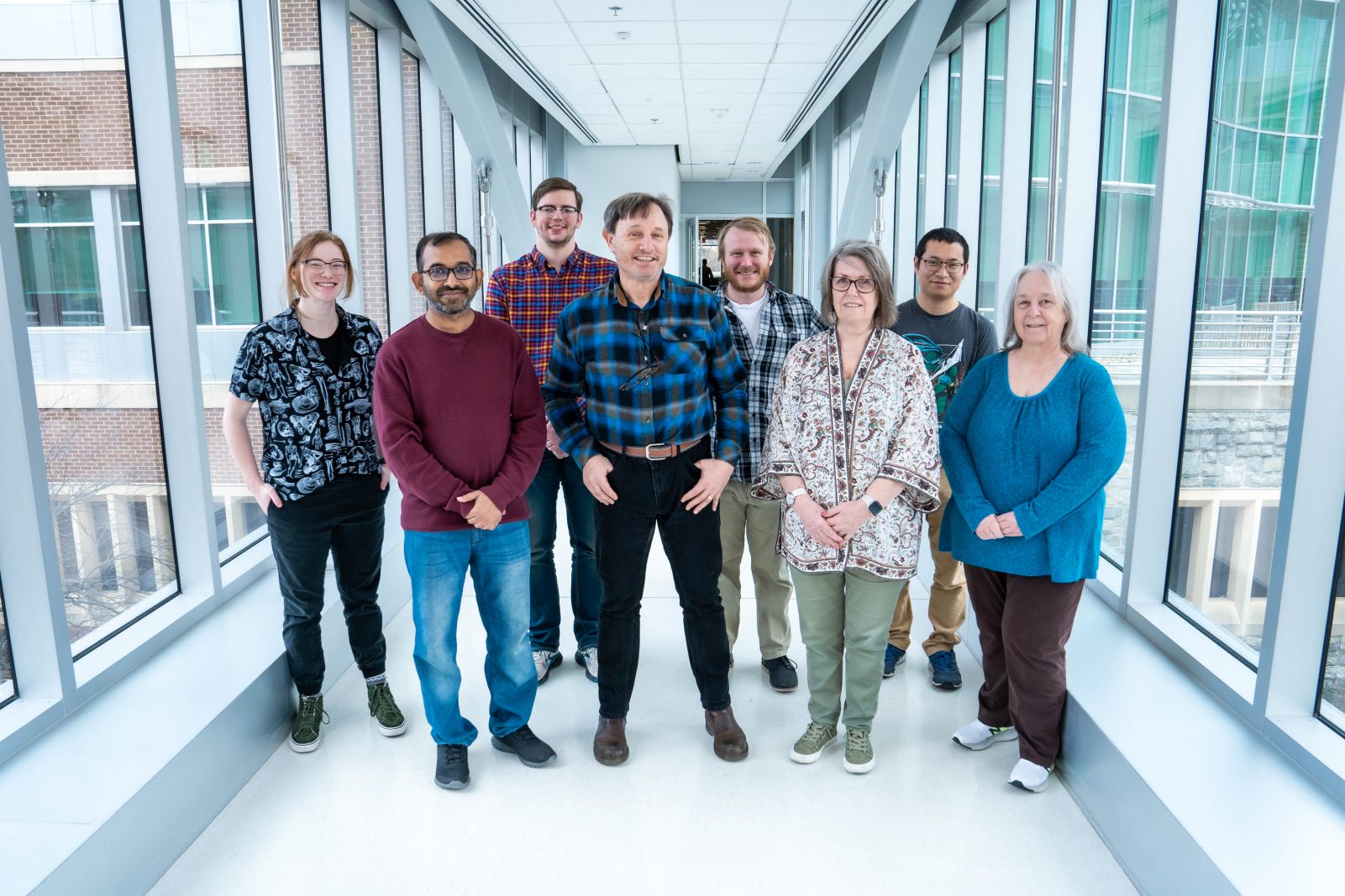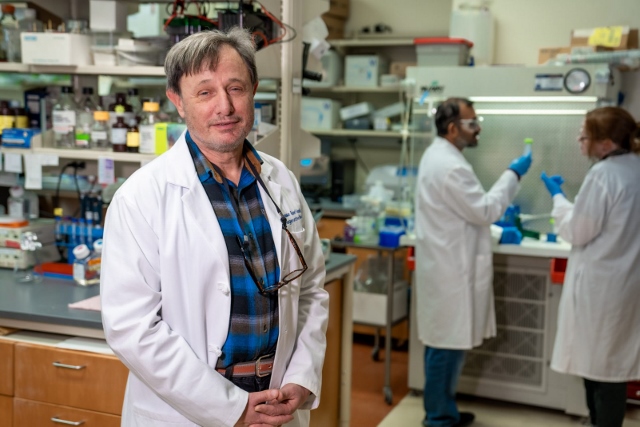Robert Gourdie has never gone to work wondering what he was going to invent next. Yet, the inventions keep coming.
A professor at the Fralin Biomedical Research Institute at VTC, Gourdie was named a senior member of the National Academy of Inventors and a rising leader in his field with success in patents, licensing, and commercialization on Feb. 14.
“I’m lucky enough to have a job where every day I get to come in and think about questions that catch my interest,” said Gourdie, director of the Fralin Biomedical Research Institute Center for Vascular and Heart Research. “It is like never leaving school – we’re here to learn from each other, learn from the literature, and also learn from our experiments. I’m in the laboratory interacting with our students, postdocs, and lab members. That’s basically our chance to learn, then to write and talk about it. Along the way, you manage to discover some things and even file some patents and start companies.”
Gourdie, who also holds an appointment in the Department of Biomedical Engineering and Mechanics in the College of Engineering, is a cell biologist and entrepreneur who creates knowledge and translates discoveries into solutions for medical problems.
Gourdie’s early research started at the very basic science level, when he observed different cells and started asking questions about how they interact.
https://video.vt.edu/media/1_118co9nh
His lab — then at the Medical University of South Carolina — was experimenting with different combinations of amino acids and the idea that they could be useful to influence health. Amino acids are molecules found in all living things and are crucial for life to exist. Long chains of amino acids are called proteins, and short chains are called peptides.
One potentially helpful amino acid combination Gourdie created was a peptide called alphaCT1, or aCT1, a first-in-class compound to aid in cell communication. He co-founded a company formerly called First String Research and recently renamed Xequel Bio Inc. in South Carolina to create a topical gel containing aCT1 to treat venous leg ulcers and diabetic foot ulcers — chronic medical conditions that are rising in the United States along with the rate of diabetes.
“When Dr. Gourdie homed in on the aCT-1 peptide as a potential therapeutic to treat wound healing, the gates of innovation and advancement not seen in the field in decades were opened,” said Michael Friedlander, executive director of the Fralin Biomedical Research Institute and Virginia Tech vice president for health sciences and technology. “But Dr. Gourdie was not content to simply work out the mechanism of the interactions of that peptide with its target molecules and cells and publish findings. He envisioned the potential therapeutic effects, rolling up his scientific sleeves again to do the additional layers of hard work necessary to advance this discovery from the laboratory to clinical application through the marketplace. These steps often daunt otherwise creative scientists like Dr. Gourdie, but he met it head on.”
The aCT-1 peptide proved to be versatile. It is now also in human phase III clinical testing for cutaneous radiation injury. Phase II testing is also under way to test its properties for treating corneal tissue damage on the surface of the eye.
Now, Gourdie is exploring ways to orally deliver the compound so that it selectively reaches internal areas of the body where tissue damage has occurred in order to provide direct on-target facilitation of tissue repair.
“Dr. Gourdie is tackling one of the most vexing challenges in pharmacology — the delivery of precision therapeutics to the appropriate target sites in the body,” said Friedlander, who wrote in support of Gourdie’s nomination to the National Academy of Inventors. “Dr. Gourdie had the insight to develop a drug delivery system to load medicine into natural vehicles called exosomes, which are derived from milk. In this way, the therapeutic payloads can be delivered orally to do their work while remaining protected from digestion in the gastrointestinal system and from attack from the body’s immune system.”
To move further toward that end, Gourdie started the Tiny Cargo Company Inc. in Roanoke to develop the utility of peptides such as aCT1 from exclusively topical applications to oral administration, thus making it more useful for a number of potential therapeutic uses, including curbing effects of tissue injury from radiation exposure to military and civilian personnel and for helping protect cancer patients from some of the unwanted side effects of radiotherapy.
Cancer, the second leading cause of death in the U.S., is also in Gourdie’s sights for an intervention. He co-founded with Samy Lamouille, an assistant professor at the Fralin Biomedical Research Institute, Acomhal Research in Roanoke to explore the potential of another of his first-in-class peptide-based compounds to obliterate cancer stem cells that survive conventional chemotherapeutic treatment.
The peptide drug is less toxic to normal cells and prevents cancer stem cells from forming new tumors. It may be potentially effective against malignant brain tumors as well as breast, colon, lung, and pancreatic cancers.
Gourdie said when he first started studying cell interactions, none of these applications were in sight.
“That’s the amazing thing about research, and why it’s important to support it,” Gourdie said. “It’s sometimes hard for non-scientists to understand, but sometimes working on the littlest, most arcane things can lead to discoveries that ultimately prove to be of great value.”
That includes little chains of amino acids.

At Virginia Tech, an important step in bringing an invention to market in the commercialization process is for faculty to work with Innovation and Partnership’s LINK + LICENSE + LAUNCH team. LICENSE offers technology commercialization services to support licensing of technologies to existing companies and promote start-up formation. LAUNCH works directly with faculty and graduate students to shape ideas and discoveries and bring key resources to innovators seeking to start new companies.
Gourdie was nominated for senior membership in the National Academy of Inventors by Virginia Tech President Tim Sands. He will be formally inducted June 26 in Washington, D.C.
Just as he gradually found helpful inventions by chaining amino acids together, Gourdie never expected to be recognized by the National Academy of Inventors — another fortunate consequence for pursuing answers to questions that he found interesting.
“I am very grateful to the people who nominated and endorsed me,” Gourdie said. “This is a fantastic honor, and it shows how it is so important to be surrounded by people who are also energized and interested in what they’re doing. We have a great team of different people with complementary skill sets, and operation of the team is as important as any element in the process of discovery. But it’s not just my team, it’s many teams full of talented, curious, and lively people at the Fralin Biomedical Research Institute. I think the environment itself is another important aspect of that process of creativity.”
In December, Rafael Davalos, the L. Preston Wade Professor in biomedical engineering and mechanics in the College of Engineering, and Roe-Hoan Yoon, a University Distinguished Professor in the Department of Mining and Minerals Engineering and director of the Center of Advanced Separation Technologies, were named to this year’s cohort of National Academy of Inventors fellows and will be formally inducted June 27, also in in Washington, D.C.

